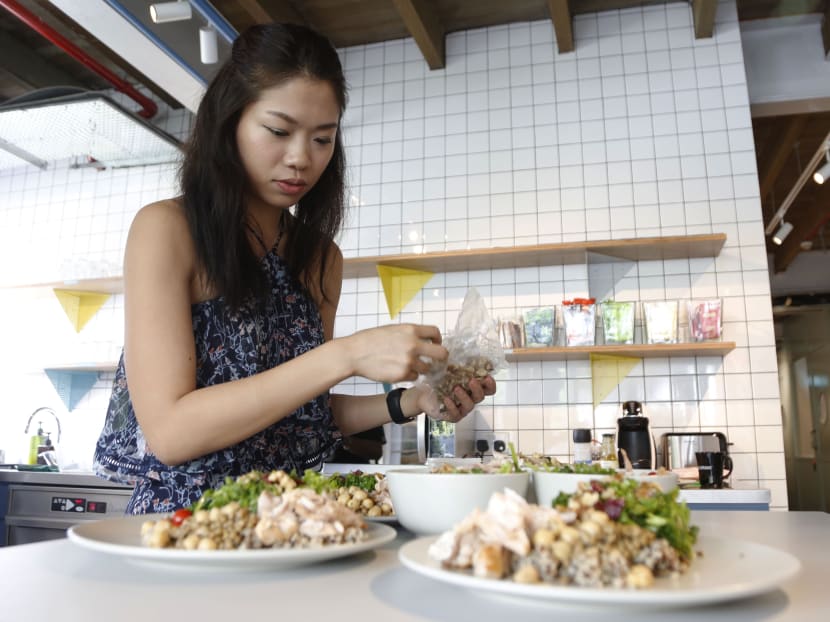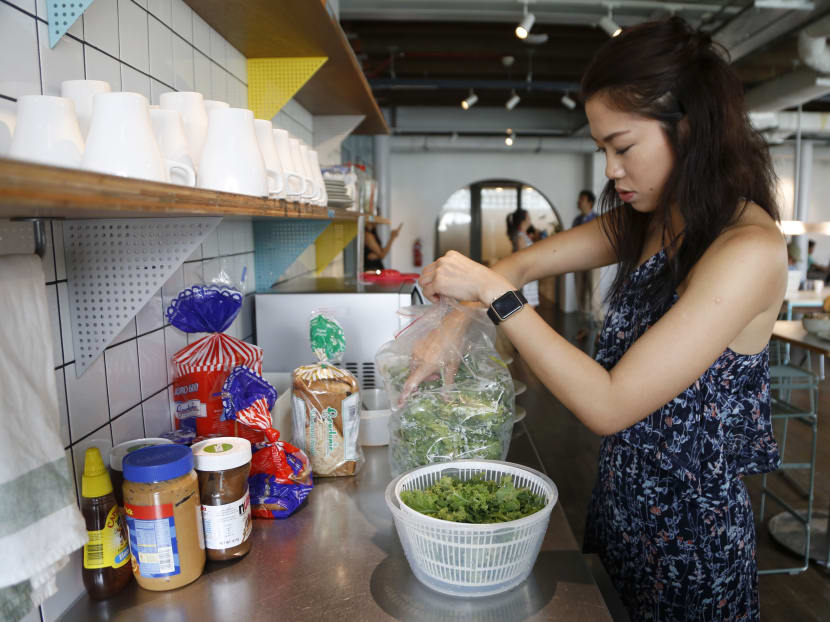Flexi-work arrangements helped 2 women to eat better, healthier
SINGAPORE — Doing her bit to promote healthy eating, Ms Rachel Kok started a lunch-time salad club three months ago with people she met at work, to teach them “innovative ways” of preparing salads.


SINGAPORE — Doing her bit to promote healthy eating, Ms Rachel Kok started a lunch-time salad club three months ago with people she met at work, to teach them “innovative ways” of preparing salads.
It all began five months ago when the 29-year-old businesswoman moved her workstation to The Working Capitol on Keong Saik Road, which provides “co-working spaces” for hire to organisations or individuals who want flexible places to work, meet or hold events.
She started making and packing her own meals, which generally consists of quinoa, soba or glass noodle salads, and other wholesome ingredients.
“I noticed (the people there) looking at my lunch, and when I let them try it, they said it was very nice,” she said.
Shortly after, Ms Kok came up with the idea of teaching them to prepare their own salads. Her food club now has five to six members, including herself.
Every morning, she will prepare extra portions of her own food to be shared with the rest. At the pantry in the workplace during lunch, she will show them how to make their own salad and dressing.
The cost of the ingredients, which is split among the group, works out to around S$5 per meal.
Under her influence, club members have started to eat better. Ms Samantha Chin, 27, who works in the marketing line, sometimes try to make use the same recipes at home. “My family loves it. Our whole family is eating better,” Ms Chin said.
Ms Kok was not always so health-conscious. She used to binge on potato chips at home, or have fried food at hawker centres frequently.
Although her body mass index was in the healthy range, five years ago, she decided that she wanted to shed a few kilograms. “I eat a lot, and I didn’t like being hungry. So I decided the only way was to eat healthily, rather than cut down on my intake,” she reasoned.
She introduced wholemeal bread to her parents and baked sugarless pumpkin muffins for them as breakfast items. Her own breakfast is usually homemade granola and yoghurt.
Half a year into her diet, she lost 6kg.
Not everyone was receptive to her new choices though. Her friends, for example, often shot down her suggestions to opt for healthier food, so she would have dinner on her own before joining them at gatherings.
About two years ago, after she split up with her boyfriend, Ms Kok stopped having meals alone. “At that point, I was hurting. I needed to reach out to people, so I started to spend more time with my friends.”
She was also aware that she was becoming “too obsessed” with eating well. “I felt I was overly particular, and I didn’t want to be so hung up over food.”
These days, she has no qualms eating out, and would order a salad or soup when socialising over meals. She exercises daily, so she is also not too strict with herself when it comes to having desserts.
She continues to choose healthy food whenever she can. Each month, she spends about S$200 to S$300 shopping for food items at the supermarket.
Like Ms Kok, Ms Bella Koh, 36, who is self-employed, made a conscious decision to eat healthier.
Around 2009, the product developer who worked in the fashion industry left her job to take a break.
Ms Koh said that she could not manage her eating habits well when holding down her previous job, where the working hours often stretched past 9pm and she would take her dinner after that.
“I was drinking a lot of coffee with dairy, and I felt bloated. I would have gastric at 7pm every day at work,” she recalled.
After work, she overindulged in food to relieve stress. There would be days when she would have beef, prawns and chicken in a single meal.
After she quit her job, Ms Koh started to have homemade meals daily. She tried vegan and pescatarian (seafood) diets, but started eating meat again after craving fried chicken during her pregnancy a few years ago.
Now, breakfast would consist of an avocado, lunch would be noodles, cous cous or quinoa, and dinner would be wholegrain rice with dashi broth and seafood. Her two-year-old daughter follows a similar diet.
When buying groceries, Ms Koh pays attentions to the food labels, choosing cold-pressed olive oil, or coconut oil, and pink salt as cooking condiments because they are believed to be more nutritious. She also buys organic food.
“Everyone thinks that organic products are expensive, but they’ve become cheaper over the years because more people are buying them,” she said, adding that her monthly grocery bill comes up to S$400 to S$500.






